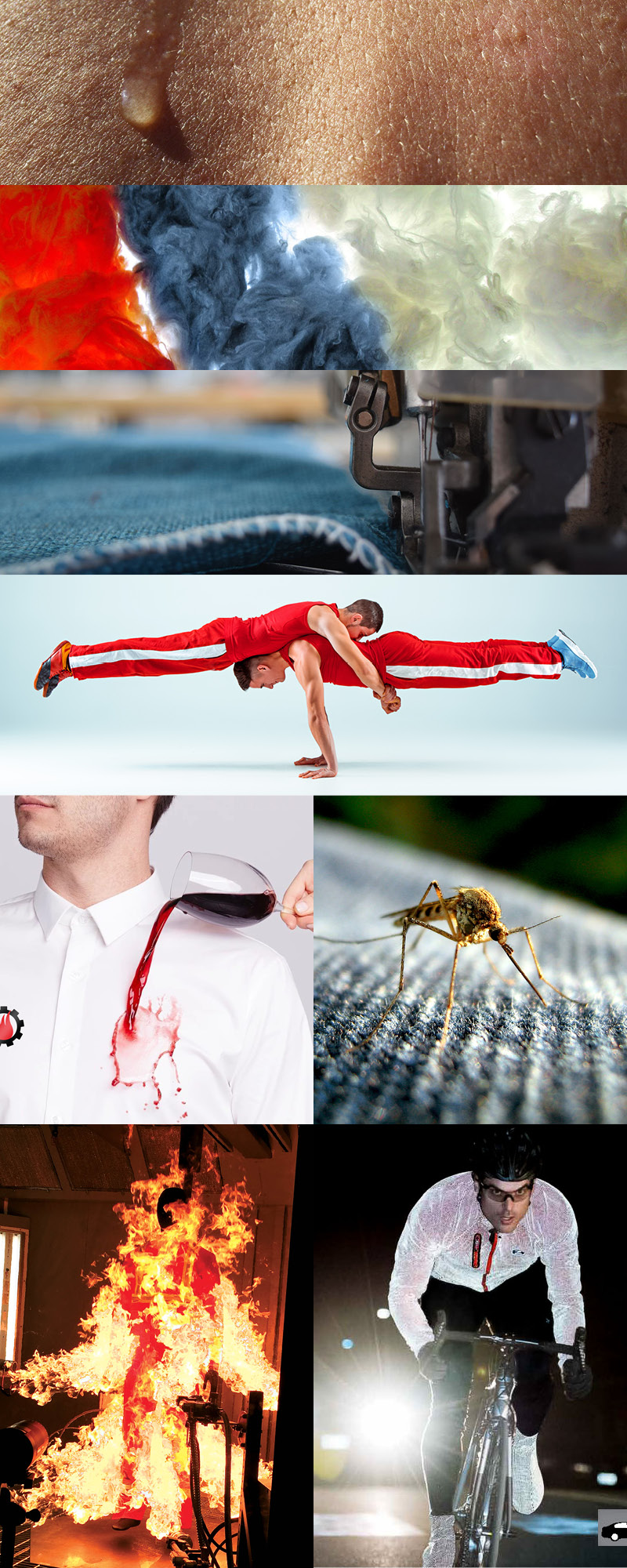I think I broke a sweat.

(from the top) A little sweat, a ton of research lets hard work and those guys in the middle do their incredible thing in comfort wearing some really high-tech gear. (bottom four) Ain’t technology great??? Some of the “performance fabrics” characteristics repel stains and dirt, repel mosquitos, protect you against heat & fire and make you super visible at night but still look stylish by day.
A funny thing happened the other day, something that’s not happened in months here in cloudy, cold Cleveburg … I think I broke a sweat. With the thermometer FINALLY creeping up past “man it’s cold”, combined with the warmth of the direct sun, I could feel my body temperature rising, and after running a bit, a tiny bead of sweat trickled on my forehead. Granted with my forehead there are always more than a tiny bead! Problem was, I had on one of those new-fangled shirts that removes the moisture from my body, so I wasn’t quite sure what was going on. Being a science geek at heart, and thinking about my upcoming post, I jumped on the internet to see what I could share – and of course, learned way more than I thought. For one, the category of fabric is called Performance Fabrics, meant for providing extra comfort under extreme conditions … (sure wish they had this stuff the day I got married!). Here’s some cool (get it?) info to add to your brain, and more than you’d likely ever know about today’s active wear. Thanks Wikipedia, and slate.com for the insights.
- Performance fabrics are fabrics engineered for a wide variety of uses where the performance of the fabric is the major parameter. Performance fabrics may be used in active wear, sportswear, summer and winter wear, mountain activities, trekking, work wear, in military, as well as urban wear and protective wear.
- The performance of a fabric/garment is enhanced or achieved by a number of processes like selection of fibers and blending of the performance fibers during spinning, knitting or weaving along with other yarns like cotton, viscose, bamboo, polyester, acrylic, nylon, and elastane. By processing and finishing with chemicals (also known as functional finishes) during dyeing or at finishing stages by padding or coating, materials are durable, functional and great looking.
- Most performance fabrics are made in layers (think big “dagwood” sandwich), with a soft inner layer, protection layer, waterproof membrane, another protection layer and an abrasion resistive outer layer. Depending on the use, thickness varies. Some performance wear is almost too thin to realize the technology is at work, such as stretch / yoga pants.
- Nanotechnology(precisely manipulating atoms and molecules for fabrication of macroscale products)is used to provide high durability for performance fabrics because nano-particles have a large surface area-to-volume ratio and high surface energy, leading to an increase in durability and function.
- Some newly engineered fabrics are also known as value-added textiles– high performance and cost-effective smart fabrics and interactive textiles enabled to replace traditional materials (think old cotton shirts) and become popular among many end-users. For some hard-core athletes, nothing beats a soaking wet t-shirt.
- High performance fabrics, (such as those which are both flexible and flame retardant) are being used for industrial workwear, in the armed forces, in firefighting forces, and in the welding industry, for protection and stain resistance.
- Different performance fabrics have various characteristics. Some varieties of performance fabrics are capable of blocking harmful ultraviolet radiation, and have protection from ticks and mosquitoes, include Quick Dry, temperature control and antimicrobial or anti-odor properties. Special performance fabrics may also possess pilling-resistance, wrinkle resistance, and stain (water, dirt and oil) resistance, and be antistatic, self-cleaningand flame resistant. In some cases, they can be engineered to be extra resistant to wind, heat and abrasion.
- According to Dr. Roger Barker, a professor at NCSU’s College of Textiles, “Wicking fabric works because of two factors that are designed into the material. One fabric has some type of capillary action and the other is water repulsion. All wicking-type materials use a capillary action to pull the moisture away from the body. The fabric is designed to spread sweat throughout the material, not on the skin. Areas with a lot of moisture will bleed the water into a drier area. The material is also designed to help air circulate between the skin and the fabric for faster evaporation.”
- To increase the wicking process, the fibers in the fabric are either coated with a water repellent or the repellent is woven into the material. The woven repellent is usually some type of polyester fiber or a microfiber. Microfibers, by the way, are not fibers themselves, but a technology that is used to produce an ultra-fine fiber that is then woven or knitted into a high-quality fabric.
- Many high-performance type shirts are also treated with gore-tex, a water-repellent coating that is added to the material. Since the fabric repels water, sweat tends to bead up and then evaporate in the layers, rather than be absorbed into the cloth. That allows the shirt to dry quicker.
- Some athletes consider it possible that these shirts do their job too well. Field research shows that the extra high wicking fabrics can actually increase the risk of injury, fatigue, overheating, and dehydration by not allowing sweat to affectively cool the body through evaporation against the skin. By drawing sweat away from your skin, as soon as it rises to the surface, your body won’t cool properly – making you sweat even more, which will lead in turn to dehydration and compromised muscle performance. Now as you read this there will be one or two of you out there, myself included for which this will most likely never be a problem! For the rest of you, remember stay hydrated!


